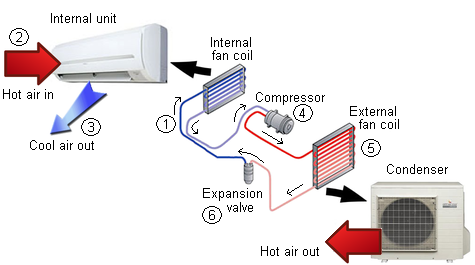For over half a century, McKinnon Heating & Cooling has been at the forefront of providing exceptional heating and cooling solutions to families across Melbourne and the Mornington Peninsula. Our legacy is built on a foundation of dedication, expertise, and a commitment to ensuring our customers' utmost comfort.
HEATING FAQHydronic Heating
If you live in an urban area, the cheapest fuel is natural gas. Solid fuel is an option, but is only more economical if it is available at little or no cost ($60 per tonne or less). If natural gas is not available, the cheapest fuel is generally solid fuel. However, intensive labour is required to keep the boiler operating effectively. LPG is an option in areas without natural gas, but is more than two and a half times more expensive, depending on where you live.
Although known as panel ‘radiators’, panels provide both radiant and convective heat output. Radiant heat is emitted from hot surfaces and heats objects in a room directly, but does not directly warm the room air.
Convective heat comes from air being warmed and circulated around a room. In general, consider maximising the amount of radiant heat output if you have higher ceilings (3.0 metres or above). A higher proportion of radiant heat also tends to maximise the comfort of room occupants.
The following diagram shows the different types of hydronic panels which are available:

What features should I look for in a hydronic system?
- Low water content boilers should be manufactured from a lightweight metal such assteel or copper. Avoid cast iron or similar heavyweight materials.
- Choose panels with a low water content. This improves response time and reduces energy use.
- Response time—pressed steel panels have a faster response time than cast iron panels, and are around 10–15 minutes quicker in heating a room.
- All piping should be well insulated to guard against heat loss. Materials such as Armaflex, Bradflex or Insulzip of at least 10 mm thickness should be used—ordinary pre-lagged copper pipe is insufficient.
- A thermostat should be installed in the main living area (usually the family room). This should be located on an internal wall in an area free of draughts, and away from sources of direct heat, such as system panels or direct sunlight. Programmable thermostats give a higher degreeof control than conventional types.
- Panels in other rooms should have individual valves, allowing rooms to be heated independently. Individual room heating can substantially lower running costs.
- Thermostatic valves are generally recommended, especially in rooms that gain heat from other sources such as direct sunlight. Increased comfort levels are achieved as desired temperatures are maintained.
- Consider mounting an insulating board on any uninsulated walls behind panels to reduce heat loss. Up to 30% of heat produced can be lost through such walls. Thin foil board or foil alone is practical and economical.
- Good overall system design is critical and should be done by a professional with experience in designing hydronic systems. The approximate proportions of radiant and convective heat from the different types of panels are as follows:
- Only heat the rooms you are in or will immediately use and not your whole house unless necessary.
- At night, turn the system off or set the thermostat to less than 12°C.
- Maintain the thermostat on the lowest comfortable temperature (18–20°C in living areas). Bedrooms, studies, halls and other infrequently-used areas should be heated to a maximum of 16–18°C.
A hydronic system consists of four components:
- The boiler heats water to a thermostaticallycontrolled temperature. Boilers use natural gas, LPG, off-peak electricity or solid fuel*.
- The piping, usually made of copper (occasionally plastic), carries the heated water from the boiler to radiators/convectors or into the slab, and back again for reheating.
- A pump circulates the water through the piping.
- Radiators or convectors transfer heat to the room. Several types are available.
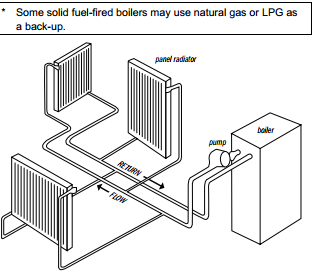
- Individual control valves to each panel allow individual rooms or zones* to be heated independently, enabling running costs to be substantially lowered.
- Panel radiators can provide effective heating for rooms with higher ceilings (details on which radiator types are suitable for areas with high and low ceilings are discussed over the page).
- There is no dust circulation and air movement with silent radiant heat distribution (unless using fan convectors).
- Flexibility as further radiators or convectors can be added to a system as required, provided there is adequate boiler capacity.
- Response time is generally good, and you will feel warm within 30 minutes.
- Low maintenance requirements.
- The proven effectiveness of hydronic heating—it has been widely used in Europe for almost a century.
Hydronic heating uses hot water to provide whole home heating. If used wisely, it can be an economical and highly effective form of central heating. In most hydronic systems, the water is heated in a boiler, and then pumped through piping to panel radiators or convectors positioned in each room. Heat is transferred directly from these to the room air. In-slab (‘floor coil’) systems are also available. In these, the heated water is pumped through piping laid in a concrete slab floor duringits construction. Heat is released into the slab, and subsequently into the room.
Gas Ducted Heating
- Australian Gas Association research found that gas ducted central heating produced just one third of the emissions of heating produced by black coal-generated electricity (Source: Assessment of Greenhouse Gas Emissions from Natural Gas, Australian Gas Association, 2000).
- When it gets really cold outside, reverse cycle systems lose efficiency, while Braemar ducted gas systems keep your home as warm as you want it – no matter how cold it gets outdoors!
- Ducted gas heating provides instant warmth that won’t dry out your eyes.
- Ducted gas heating heats your whole home – delivering lovely warm air through unobtrusive vents in the ceiling or floor.
- You get fingertip control – increasing or decreasing the temperature to suit you and your family.
A ducted gas heating system includes a number of essential components:
Gas heaters work by passing cold air over a heat exchanger, which is warmed by gas combustion. The warmed air is then pushed through ducts into the home via a series of vents in the ceiling or floor.
A thermostat is installed in the main living area. This senses the air temperature inside the home and sends a signal to the heater to cycle on, or off, to maintain the desired temperature.
The products of combustion are all discharged safely outside the home, via a flue.
COOLING FAQEvaporative Cooling
The amount of water an evaporative cooler uses depends on the evaporation rate of the coolers pads. The more water the cooler evaporates the more cooling potential the cooler has. The evaporation rate varies depending on the outdoor weather conditions, the size of the cooler, the speed of the coolers fan, the velocity of the air through the pads and the condition and type of the filter pad material.
This is dependant on the size of cooler and the size of the room being cooled. Generally, windows will need to be open in each room being cooled. The Owners Manual will have a guide to the size of open area required for each model, in m², and also give suggestions on how to provide this.
No, the differing technology and air volumes between ducted heating and evaporative cooling don’t allow the units to share the same ductwork.
Evaporative cooling is typically less expensive to install, run and maintain than refrigerated cooling. It provides 100% fresh air instead of recycled air and is cooled by water meaning it won’t dry out the air which can occassionally cause irritation to your eyes or throat. Windows & doors can be left open, allowing you to enjoy outdoor living.
Ducted evaporative cooling comprises of a central cooling unit, connected to a series of outlets. Positioned strategically throughout the house, these outlets, or ducts, are installed in the ceiling while the cooling unit is installed on top of the roof.
The cooling unit draws in fresh air from outside your house (the hotter the air is to begin with, the better the cooling effect). As it passes through moistened pads, the air is cooled and filtered before flowing through the duct work and into your rooms.
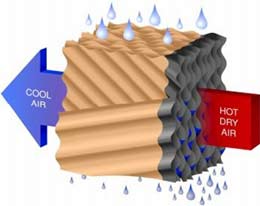
Reverse Cycle
The energy efficiency of air conditioners sold in Victoria is reflected in a compulsory energy star rating labelling scheme for units up to 7.5 kW cooling capacity (most ducted systems are not rated). The more stars shown on the label the more efficient the unit. The label also gives an estimate of the annual electricity consumption.
Check the Energy Rating label on air conditioners in retail showrooms or visit the Energy Rating website (www.energyrating.gov.au) for a detailed, up-to-date list of appliances. High-efficiency units may cost more but can easily pay for themselves over a few years through lower running costs.
- Rooms in which the air conditioner is being used should be closed off so the room air is recirculated. For example, windows and doors should remain shut. If possible locate window/wall units on the south side of the house. If the unit is exposed to full sun during the day, shade it with an awning or canopy of shade trees. However, do not restrict air flow over it.
- Set thermostats at 26–27°C for summer cooling. Each degree you lower the thermostat can increase running costs by up to 15%.
- Look for economy settings.
- Multi-speed fans allow you to select high speeds for fast circulation and quick cooling.
- Adjustable and rotating louvres also help to direct air movement more evenly around the room.
- Directional louvres set either horizontally or upwards toward the ceiling assist in cooling.
- Programmable timers allow the system to be switched on or off as required.
Portable units
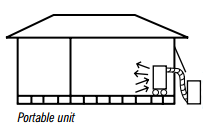
- Separate indoor and outdoor unit connected by a flexible hose through an open window or external door.
- Plugs into standard power outlet
- Suitable for: rooms up to 35 m2
Approximate Purchase Cost: $800–$3000
Window/Wall
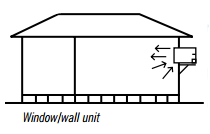
- Requires external window or wall
- Small units can use existing power outlets
- Larger facia units may require additional wiring
- Outside coil should be shaded if possible
- Suitable for: single room cooling up to 60 m2
Approximate Purchase Cost: $500–$1600 (plus installation)
Split System Units
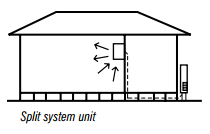
- Separate indoor and outdoor section
- Ideal where no suitable window or external wall location exists
- Very quiet indoor operation
- The indoor unit can be located up to 15 metres away from the outdoor unit.
- The indoor unit can be wall, ceiling or floor mounted
- Multi split systems—can have up to seven indoor units running off one outdoor unit.
- Inverter technology is available with several brands of reverse-cycle split air conditioners. This allows the compressor to operate at variable speeds depending on the output required, and can potentially reduce running costs, particularly over longer operating periods.
- Suitable for: one or more rooms up to 60 m2. For larger areas, three phase powered units will be required.
Approximate Purchase Cost: $1000–$10 000 (multi splits) plus installation
Ducted Systems
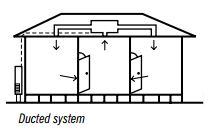
- Roof or ground mounted, connected to ductwork
- Generally less efficient than split or window/wall units due to ducting losses
- Systems should be zoned to cool livingand sleeping areas at different times
- Ductwork should be well insulated and sealed to prevent condensation
- Works best if ceiling mounted
- Suits pitched roof homes
- Suitable for: Whole home cooling
Approximate Purchase Cost: $6000–$12 000 (includes installation)
Geo-exchange (or geothermal) heat pumps use the heating and cooling capacity of the earth to provide the air conditioning requirements of a home. These systems remove heat from the air inside the home and transfer it to the ground or ground water. In winter the process is reversed to provide heating. They are extremely efficient but more expensive to purchase than conventional ducted air conditioning systems.
Refrigerated air conditioners are effective in any climate, however, they are particularly useful in humid areas because they also work to dehumidify the air which is recirculated through the system.
The correct sizing of an air conditioner is vital for efficient operation. Never oversize an air conditioner. Oversizing will result in short cooling cycles (switching on and off), with little reduction in humidity. Also, frequent cycling (on and off) is not efficient and adds to the wear and tear on the unit. An undersized air conditioner will not provide adequate cooling. Air conditioners should be sized based on their output power or cooling capacity (not to be confused with the electrical input).
The output is normally expressed as kW (kilowatts). 1 kW = 1000 Watts. Sizing is sometimes quoted in horsepower (HP), which is generally the input power, which can lead to inaccurate sizing and should be avoided. As an approximate guide for sizing a room unit in Melbourne, allow 125 Watts or 0.125 kW per square metre of floor space for living areas and 80 Watts per square metre for bedrooms. Remember, have a full cooling load calculation carried out by an authorised air conditioning installer or manufacturer before purchase.
Refrigerated air conditioners consist of an indoor and outdoor coil. These are connected by a pipe carrying a refrigerant gas. As warm room air is drawn over the internal coil, heat from this air is absorbed by the refrigerant and carried to the external coil where it is released outside.
At the same time any water in the room air condenses on the cold internal coil and is then drained away. The resultingair blown back into the room is now cooler, less humid and usually filtered. Some units also provide a small amount of fresh air from outside into the room
